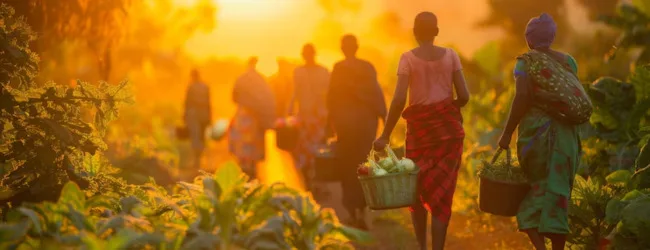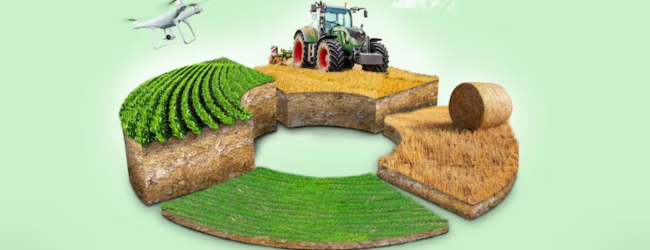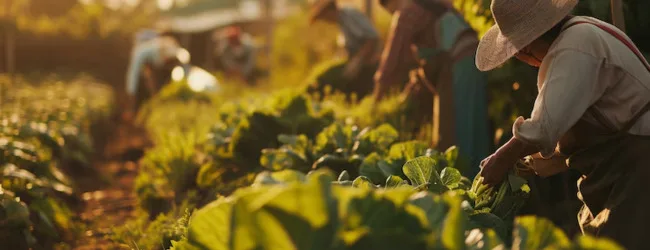Table of contents
Farming, the backbone of human civilization, has evolved significantly over millennia. From traditional methods reliant on manual labor and natural cycles to modern, technology-driven approaches, the diversity in farming practices reflects the varied needs and environments across the globe. As we move towards 2025, the focus is increasingly shifting towards sustainable farming methods that ensure food security while minimizing environmental impact. This blog explores the different types of farming and highlights the top sustainable practices shaping the future of agriculture.
Types of Farming
Farming, in its essence, is the cultivation of land and the rearing of animals for food, fiber, and other products. However, this fundamental activity manifests in a multitude of forms, each shaped by environmental factors, economic pressures, technological advancements, and societal needs. Understanding the nuances of these different types of farming is crucial for appreciating the complexity of agriculture and for navigating the path towards more sustainable food systems.
Here’s a deeper dive into various categories of farming:
1. Subsistence Farming

- Definition: This is the oldest and most basic form of agriculture, where farmers primarily grow crops and raise livestock to meet the direct consumption needs of their household. The primary goal is survival, with little to no surplus generated for sale or trade.
- Characteristics:
- Small Land Holdings: Farmers typically cultivate small plots of land.
- Family Labor: The majority of the work is done by family members.
- Traditional Tools: Simple, often manual tools and techniques are employed.
- Low Input: Minimal use of fertilizers, pesticides, and modern irrigation. Reliance on natural fertility and rainfall.
- Mixed Cropping: Often involves growing a variety of crops together to ensure food security and soil health.
- Integration with Livestock: Small numbers of animals may be raised for milk, meat, and draft power.
- Dependence on Environment: Highly susceptible to weather conditions and soil fertility.
- Prevalence: Still prevalent in many rural and remote areas of developing countries, particularly in parts of Africa, Asia, and Latin America. In India, it’s common in the eastern and northeastern regions.
- Examples: Shifting cultivation and nomadic herding can be considered early forms of subsistence agriculture.
2. Intensive Farming
- Definition: This system aims to maximize crop and livestock output per unit of land through higher inputs of labor, capital, and technology. The focus is on increasing productivity from a limited area.
- Characteristics:
- High Input: Significant use of fertilizers, pesticides, herbicides, irrigation systems, and high-yielding varieties of seeds or breeds of animals.
- Mechanization: Increased reliance on machinery for various farm operations.
- Specialization: Often involves focusing on a few high-value crops or a specific type of livestock.
- Careful Management: Requires precise management of resources and growing conditions.
- Higher Yields: Aims to achieve significantly higher yields compared to extensive farming.
- Can be Commercial or Subsistence: While often commercially oriented, intensive methods can also be used in smaller-scale farming to maximize output for a family’s needs.
- Examples: Market gardening, poultry and dairy farming in developed nations, and rice cultivation in densely populated regions of Asia.
ALSO READ | Earn Big with Mushroom Farming Business: Step-by-Step Guide
3. Extensive Farming
- Definition: This system utilizes large areas of land with relatively low inputs of labor, capital, and technology per unit area. The focus is on maximizing output by utilizing a large land base.
- Characteristics:
- Large Land Holdings: Farms typically cover vast tracts of land.
- Low Input per Unit Area: Minimal use of fertilizers, pesticides, and labor relative to the land size.
- Mechanization for Large Areas: Machinery is used to manage the large land area efficiently.
- Lower Yield per Unit Area: Yields per hectare or acre are generally lower compared to intensive farming.
- Often Geared Towards Commercial Markets: Production is usually aimed at selling in larger markets.
- Prevalence: Common in regions with low population density and abundant land, such as parts of Australia, Argentina, the western United States, Canada, Ukraine, and Russia.
- Examples: Large-scale wheat farming in the prairies, cattle ranching in vast grasslands, and sheep farming in arid regions.
💡 Pro Tip: If you want to start farming but have too many doubts, connect with a farming expert from Boss Wallah for guidance – https://bw1.in/1116
4. Commercial Farming (Agribusiness)

- Definition: This type of farming is driven by profit and aims to produce crops and livestock for sale in national and international markets. It operates as a business enterprise.
- Characteristics:
- Large-Scale Production: Involves cultivating large areas of land or raising a significant number of animals.
- Capital Intensive: Requires substantial investment in land, machinery, infrastructure, and inputs.
- Market-Oriented: Crop and livestock choices are heavily influenced by market demand and profitability.
- Specialization: Often focuses on monoculture (growing a single crop over a large area) or specialized livestock production.
- Advanced Technology: Employs modern machinery, irrigation systems, and scientific research to maximize efficiency and yields.
- Integration with Supply Chains: Often involves links with processing, distribution, and marketing networks.
- Examples: Large grain farms in North America, fruit plantations for export, and large-scale poultry or pig farms.
5. Plantation Farming
- Definition: A specialized type of commercial farming focused on growing a single cash crop on a large estate (plantation) primarily for export.
- Characteristics:
- Single Crop Focus (Monoculture): Typically involves crops like tea, coffee, rubber, cocoa, bananas, sugarcane, and spices.
- Large Estates: Conducted on extensive tracts of land.
- Capital Intensive: Requires significant investment in infrastructure and processing facilities.
- Hired Labor: Often employs a large workforce.
- Scientific Methods: Utilizes scientific techniques for cultivation and processing.
- Strong Links to Markets: Production is geared towards national and international markets.
- Historical Context: Historically associated with colonial periods and often involved forced labor.
6. Mixed Farming

- Definition: Integrates the cultivation of crops with the raising of livestock on the same farm.
- Characteristics:
- Diversified Production: Farmers grow various crops and raise animals.
- Interdependence: Crop cultivation provides feed for livestock, and animal manure enriches the soil for crops, creating a cyclical system.
- Reduced Risk: Diversification provides a buffer against market fluctuations and crop failures.
- Improved Soil Fertility: Animal manure helps maintain soil health and reduces the need for synthetic fertilizers.
- Efficient Resource Utilization: Farm resources are used more effectively.
- Prevalence: Common in many parts of the world, including Europe, parts of Asia, and Africa.
7. Dryland Farming
- Definition: Practiced in arid and semi-arid regions with limited rainfall. Focuses on water conservation techniques and growing drought-tolerant crops.
- Characteristics:
- Water Conservation: Employs techniques like mulching, terracing, contour plowing, and water harvesting.
- Drought-Tolerant Crops: Cultivates crops like millets, sorghum, barley, pulses, and oilseeds that can withstand low moisture conditions.
- Fallowing: Leaving land uncultivated for a season to allow moisture accumulation in the soil.
- Soil Conservation: Practices to prevent wind and water erosion.
- Prevalence: Common in regions like Rajasthan in India, parts of Africa, and the Middle East.
8. Wetland Farming
- Definition: Agriculture practiced in areas with abundant water, often seasonally or permanently flooded lands.
- Characteristics:
- Water-Intensive Crops: Primarily focuses on crops that thrive in wet conditions, such as rice (paddy).
- Water Management: Requires managing water levels through irrigation and drainage systems.
- Specialized Techniques: Specific cultivation methods adapted to flooded conditions.
- Other Aquatic Crops: May also include the cultivation of water-loving produce like lotus, water chestnuts, and makhana.
- Prevalence: Common in coastal regions and river valleys with high rainfall or irrigation, such as the coastal regions of India and Southeast Asia.
9. Terrace Farming (Terrace Cultivation)
- Definition: A method of farming on hilly or mountainous slopes where flat steps or terraces are created to cultivate crops.
- Characteristics:
- Soil Erosion Control: Terraces reduce water runoff and prevent soil erosion.
- Water Conservation: Terraces help retain water for crop growth.
- Increased Cultivable Area: Allows farming on otherwise unusable steep slopes.
- Labor-Intensive: Construction and maintenance of terraces can be labor-intensive.
- Prevalence: Practiced in hilly and mountainous regions around the world, including the Himalayas in India.
10. Organic Farming

- Definition: A sustainable farming system that emphasizes ecological balance, biodiversity, and the avoidance of synthetic pesticides, herbicides, genetically modified organisms (GMOs), and synthetic fertilizers.
- Characteristics:
- Natural Soil Fertility Management: Relies on compost, manure, green manure, and crop rotation to build healthy soil.
- Biological Pest and Weed Control: Uses natural predators, beneficial insects, crop rotation, and manual weeding to manage pests and weeds.
- No Synthetic Inputs: Prohibits the use of synthetic fertilizers, pesticides, herbicides, and GMOs.
- Biodiversity Conservation: Promotes diverse cropping systems and the preservation of natural habitats.
- Animal Welfare: Emphasizes humane treatment of livestock with access to pasture and organic feed.
- Growing Trend: Gaining popularity due to increasing awareness of health and environmental concerns.
11. Precision Farming
- Definition: A modern farming management concept that uses technology to monitor and optimize crop inputs (water, fertilizers, pesticides) and other factors based on site-specific variability within a field.
- Characteristics:
- GPS Technology: Used for precise navigation and mapping.
- Sensors: Monitor soil conditions, plant health, and weather patterns.
- Data Analytics: Software analyzes collected data to make informed decisions.
- Variable Rate Application: Allows for adjusting inputs based on the specific needs of different parts of the field.
- Drones and Satellite Imagery: Used for field monitoring and data collection.
- Increased Efficiency: Aims to improve yields, reduce waste, and minimize environmental impact.
12. Urban Farming

- Definition: The practice of cultivating, processing, and distributing food in or around urban areas.
- Characteristics:
- Utilizes Urban Spaces: Includes rooftops, balconies, vacant lots, and vertical farms.
- Diverse Methods: Can involve traditional gardening, hydroponics, aquaponics, and vertical farming.
- Local Food Production: Aims to provide fresh produce to urban residents, reducing transportation needs.
- Community Engagement: Often involves community gardens and educational initiatives.
- Waste Recycling: Can utilize urban waste for composting.
13. Cooperative Farming
- Definition: A system where several farmers pool their land, resources, and labor to jointly undertake farming activities, including purchasing inputs, using machinery, and marketing produce.
- Characteristics:
- Collective Ownership and Management: Farmers share decision-making and profits.
- Economies of Scale: Enables access to resources and technologies that individual small farmers might not afford.
- Improved Bargaining Power: Collective marketing can lead to better prices for produce.
- Risk Sharing: Losses and gains are shared among members.
The world of farming is dynamic, with continuous innovation and adaptation. Understanding these different types of farming provides a foundation for appreciating the diverse ways in which food is produced and for addressing the critical challenges of food security and environmental sustainability in the years to come. As we move towards 2025, the integration of technology and the increasing focus on sustainable practices will likely lead to further evolution and hybridization of these farming systems.
Top Sustainable Farming Techniques
- Organic Farming: Emphasizes natural processes, avoiding synthetic pesticides, herbicides, and fertilizers. It utilizes techniques like crop rotation, composting, and biological pest control to maintain soil health and biodiversity.
- Integrated Pest Management (IPM): A holistic approach that combines biological controls (predatory insects, bacteria, fungi) with carefully selected organic pesticides and crop selection to minimize environmental impact compared to chemical pesticides.
- Energy Efficiency: Reducing energy consumption in farming operations through the use of renewable energy sources, energy-efficient equipment, and optimizing farming practices.
- Conservation Agriculture: Focuses on minimizing soil disturbance, maintaining a permanent soil cover, and diversifying crop rotations to improve soil health, conserve water, and reduce erosion.
- Agroforestry: Integrating trees and shrubs into agricultural systems to provide shade, improve soil fertility, enhance biodiversity, and create more resilient farming landscapes.
- Water Management: Implementing efficient irrigation techniques (drip irrigation, micro-sprinklers) and water harvesting methods to conserve water and prevent waterlogging.
- Crop Diversification: Planting a variety of crops increases biodiversity, improves soil health, and reduces the risk of pest and disease outbreaks.
- Precision Agriculture: Using technology (GPS, sensors, drones) to monitor and optimize crop inputs (water, fertilizers, pesticides) based on specific needs, reducing waste and environmental impact.
Key Takeaways
- Farming practices are diverse, reflecting different environmental conditions and economic needs.
- Sustainable farming techniques are crucial for ensuring food security while minimizing environmental damage.
- Organic farming, IPM, conservation agriculture, and agroforestry are key sustainable practices.
- Technology plays an increasing role in optimizing farming practices and promoting sustainability.
- Adopting sustainable farming methods requires a holistic approach that considers environmental, economic, and social factors.
Need Expert Guidance?
Starting a business can be challenging, but you don’t have to do it alone! At Boss Wallah, our 2,000+ business experts are ready to provide valuable insights and guidance. Whether you need help with marketing, finance, sourcing, or any other area of any business, our business experts are here to help you succeed: https://bw1.in/1116
Confused about Which Business to Start?
Want to start your own business but unsure which one to choose? Explore Boss Wallah, where you’ll find 500+ courses by successful business owners, featuring practical, step-by-step guides on starting and growing various businesses.
Find your perfect business idea today: https://bw1.in/1111
Conclusion
As we look towards 2025, the adoption of sustainable farming practices is not just an option but a necessity. By understanding the different types of farming and embracing innovative, eco-friendly techniques, we can build a more resilient and food-secure future for all. The transition to sustainable agriculture requires collaboration between farmers, researchers, policymakers, and consumers to create a food system that nourishes both people and the planet.
Frequently Asked Questions (FAQs)
- What is the most sustainable type of farming?
- While there’s no single “most” sustainable type, organic farming, combined with practices like conservation agriculture and agroforestry, generally has a lower environmental impact.
- How can technology help make farming more sustainable?
- Precision agriculture, using sensors and data analytics, allows for optimized use of resources, reducing waste and environmental impact.
- What are the economic benefits of sustainable farming?
- While initial costs might be higher, sustainable farming can lead to long-term cost savings through reduced input costs, improved soil health, and increased resilience to climate change.
- What are the challenges in adopting sustainable farming practices?
- Challenges include the need for knowledge and training, access to markets for sustainably produced goods, and overcoming established farming practices.
- How does crop diversification contribute to sustainability?
- It improves soil health, reduces pest and disease risks, and enhances biodiversity, making farming systems more resilient.
- What is the role of consumers in promoting sustainable farming?
- Consumers can support sustainable farming by choosing sustainably produced food, reducing food waste, and advocating for policies that support sustainable agriculture.
- How does climate change impact different types of farming?
- Climate change can lead to increased droughts, floods, and extreme weather events, impacting all types of farming, but sustainable practices can enhance resilience.
- What are some government initiatives to promote sustainable farming?
- Governments can provide subsidies, research funding, and training programs to encourage the adoption of sustainable farming practices.


